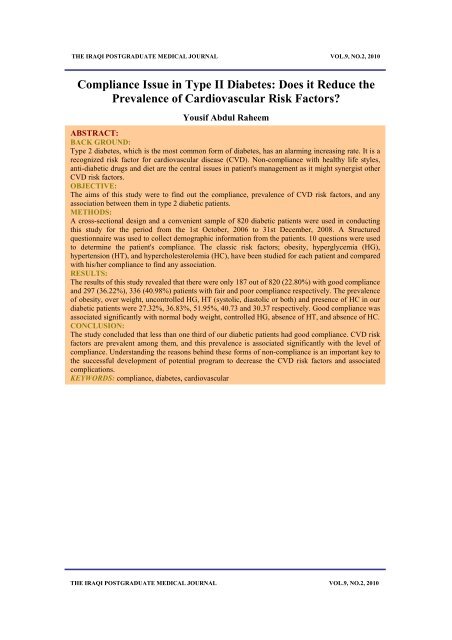The Official Journal of the Iraqi Board for Medical Specializations
The Official Journal of the Iraqi Board for Medical Specializations
The Official Journal of the Iraqi Board for Medical Specializations
Create successful ePaper yourself
Turn your PDF publications into a flip-book with our unique Google optimized e-Paper software.
COMPLIANCE ISSUE IN TYPE II DIABETES<br />
THE IRAQI POSTGRADUATE MEDICAL JOURNAL VOL.9, NO.2, 2010<br />
Compliance Issue in Type II Diabetes: Does it Reduce <strong>the</strong><br />
Prevalence <strong>of</strong> Cardiovascular Risk Factors?<br />
Yousif Abdul Raheem<br />
ABSTRACT:<br />
BACK GROUND:<br />
Type 2 diabetes, which is <strong>the</strong> most common <strong>for</strong>m <strong>of</strong> diabetes, has an alarming increasing rate. It is a<br />
recognized risk factor <strong>for</strong> cardiovascular disease (CVD). Non-compliance with healthy life styles,<br />
anti-diabetic drugs and diet are <strong>the</strong> central issues in patient's management as it might synergist o<strong>the</strong>r<br />
CVD risk factors.<br />
OBJECTIVE:<br />
<strong>The</strong> aims <strong>of</strong> this study were to find out <strong>the</strong> compliance, prevalence <strong>of</strong> CVD risk factors, and any<br />
association between <strong>the</strong>m in type 2 diabetic patients.<br />
METHODS:<br />
A cross-sectional design and a convenient sample <strong>of</strong> 820 diabetic patients were used in conducting<br />
this study <strong>for</strong> <strong>the</strong> period from <strong>the</strong> 1st October, 2006 to 31st December, 2008. A Structured<br />
questionnaire was used to collect demographic in<strong>for</strong>mation from <strong>the</strong> patients. 10 questions were used<br />
to determine <strong>the</strong> patient's compliance. <strong>The</strong> classic risk factors; obesity, hyperglycemia (HG),<br />
hypertension (HT), and hypercholesterolemia (HC), have been studied <strong>for</strong> each patient and compared<br />
with his/her compliance to find any association.<br />
RESULTS:<br />
<strong>The</strong> results <strong>of</strong> this study revealed that <strong>the</strong>re were only 187 out <strong>of</strong> 820 (22.80%) with good compliance<br />
and 297 (36.22%), 336 (40.98%) patients with fair and poor compliance respectively. <strong>The</strong> prevalence<br />
<strong>of</strong> obesity, over weight, uncontrolled HG, HT (systolic, diastolic or both) and presence <strong>of</strong> HC in our<br />
diabetic patients were 27.32%, 36.83%, 51.95%, 40.73 and 30.37 respectively. Good compliance was<br />
associated significantly with normal body weight, controlled HG, absence <strong>of</strong> HT, and absence <strong>of</strong> HC.<br />
CONCLUSION:<br />
<strong>The</strong> study concluded that less than one third <strong>of</strong> our diabetic patients had good compliance. CVD risk<br />
factors are prevalent among <strong>the</strong>m, and this prevalence is associated significantly with <strong>the</strong> level <strong>of</strong><br />
compliance. Understanding <strong>the</strong> reasons behind <strong>the</strong>se <strong>for</strong>ms <strong>of</strong> non-compliance is an important key to<br />
<strong>the</strong> successful development <strong>of</strong> potential program to decrease <strong>the</strong> CVD risk factors and associated<br />
complications. Table 1: Compliance <strong>of</strong> <strong>the</strong> diabetic patients regarding <strong>the</strong>ir demographic characters<br />
KEYWORDS: compliance, diabetes, cardiovascular<br />
THE IRAQI POSTGRADUATE MEDICAL JOURNAL VOL.9, NO.2, 2010


